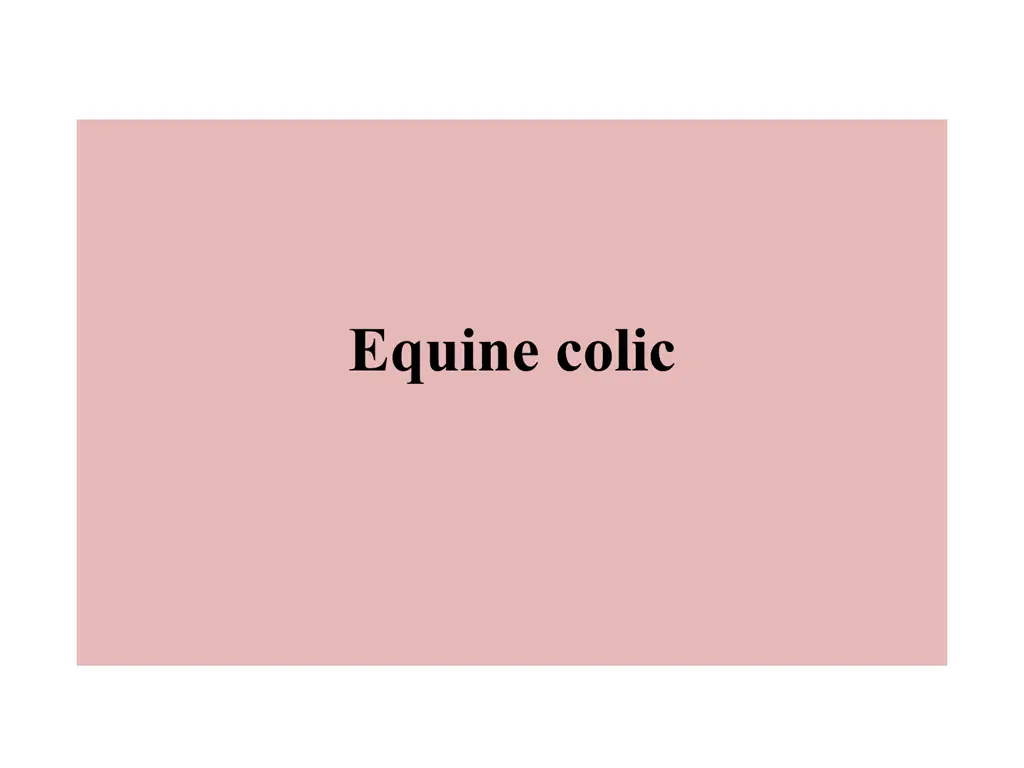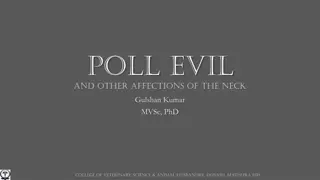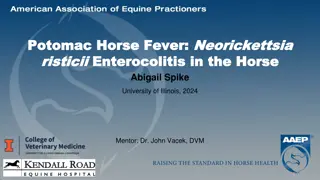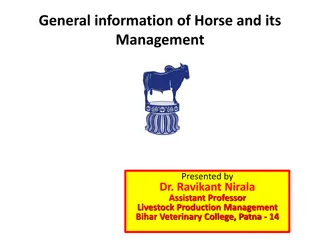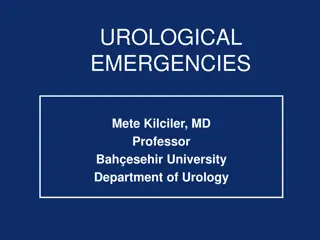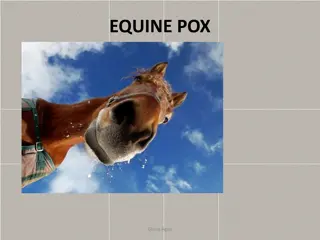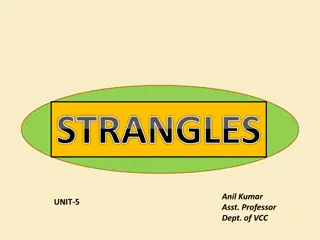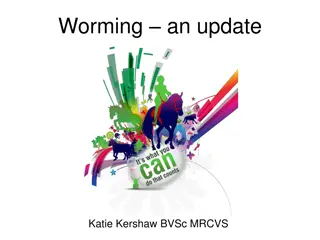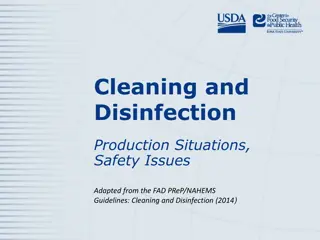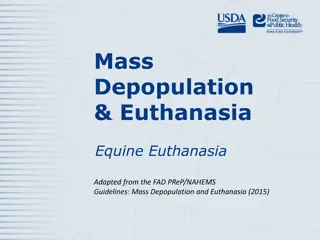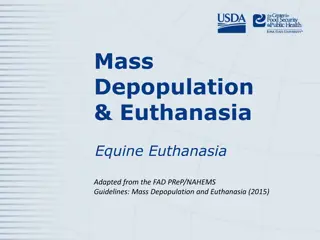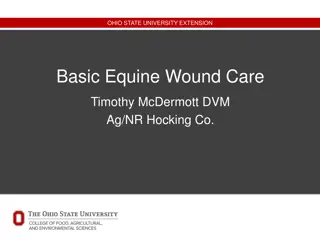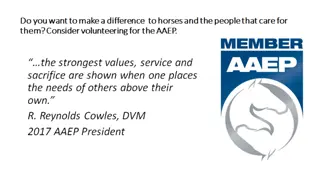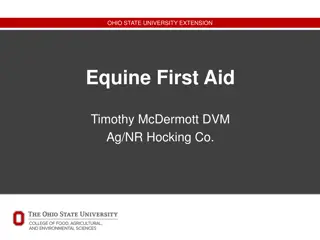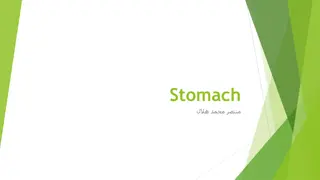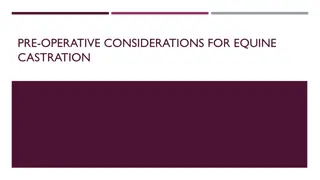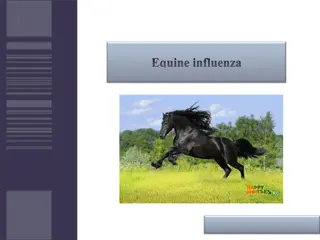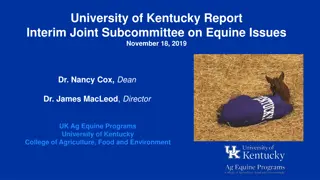Equine colic
Learn about the definition, causes, and types of colic in horses. Discover how to treat and prevent this potentially deadly condition.
Download Presentation

Please find below an Image/Link to download the presentation.
The content on the website is provided AS IS for your information and personal use only. It may not be sold, licensed, or shared on other websites without obtaining consent from the author.If you encounter any issues during the download, it is possible that the publisher has removed the file from their server.
You are allowed to download the files provided on this website for personal or commercial use, subject to the condition that they are used lawfully. All files are the property of their respective owners.
The content on the website is provided AS IS for your information and personal use only. It may not be sold, licensed, or shared on other websites without obtaining consent from the author.
E N D
Presentation Transcript
Definition The colic simply means abdominal pain in horses , it can be caused by gastric ulcers, bladder stones, twisted bowls and more. Colic in a horse can be deadly, but it is treatable, manageable and preventable. Very few horses that colic need surgery, but every colic should be treated as an emergency because some that seem harmless can worsen quickly.
Causes of Colic Gastric Ulcers - Gastric Ulcers are the number one cause of colic in horses. Anterior Enteritis - Anterior Enteritis is caused by bacteria and creates inflammation of the small intestine. The horse may have a fever, ranging from mild to moderate and pain. Large Colon or Gas Colic - Gas colic can be mildly painful, the horse could be bloated and just needs to pass gas.
Large Colon Impaction - A Large Colon Impaction is mildly painful and responds to banamine. Horses with an impaction tend to have decreased manure; the piles are too small and dry. This is often seen in winter when horses don't want to drink a lot of water. Colon Torsion - Colon torsions are moderately to severely painful for the horse, most common in mares up to six months post foaling. Enteroliths - Enteroliths are common in southern states with lots of sand, but not uncommon in Ohio. They can be clinically silent since you cannot check through a rectal exam nor an ultrasound. It is the only colic surgery where a vet can physically show the cause of pain.
Types of colic There are many different types of colic that horses can suffer from. the list below is not exhaustive, but covers the most common examples. Spasmodic colic: Also known as gas colic, pain is caused due to a build up of gas in the horse s gut due to excess fermentation within the intestines or a decreased ability to move gas through it. It is commonly caused by a change of diet, a lack of roughage or parasites. The clinical signs are generally mild and respond well to pain relief and spasmolytic medications, such as buscopan. Impaction colic: This is when a blockage occurs in the intestine. It typically responds well to medical treatment in the form of pain relief, fluids and laxatives, but some cases will require surgery. If left untreated, severe impaction colic can be fatal.
Sand colic: Most typically seen in horses kept on sandy pastures, especially when there is limited grazing available. The horse ingests sand (and dirt) which accumulates in the gut. It can lead to an impaction or it can irritate the lining of the bowel, causing diarrhoea. The weight and abrasion of the sand or dirt causes the bowel wall to become inflamed and can in severe cases, leads to peritonitis. Twisted gut: There are various parts of the horse s gastrointestinal tract that may twist upon itself, leading to an interruption in blood supply to that section. Atwisted gut is extremely painful for the horse and requires emergency surgery. Tumors and previous damage to the gut wall caused by parasites can also result in colic.
Clinical findings Horses will typically display some or all of the following:- In mild cases: Lip curling. Flank watching. Restlessness. Pawing the ground.
In moderate cases: Posturing to urinate frequently. 1. Lying down and getting back up. 2. Lying on their side for long periods. 3. In severe cases:- Violent rolling. 1. Sweating. 2. Rapid breathing. 3. Injuries to body and face from rolling and thrashing around. 4.
Treatment Analgesia and sedation 1. The most commonly used analgesics for colic pain in horses are NSAIDs, such as flunixin meglumine. 2. Butrophanol is often given with alpha-2 agonists such as xylazine and detomidine to prolong the analgesic effects of the opioid. 3. Early colic signs may be masked with the use of NSAIDs, so some practitioners prefer to examine the horse before they are given by the owner
Nasogastric intubation and gastric decompression Nasogastric intubation, a mainstay of colic management, is often repeated multiple times until resolution of clinical signs, both as a method of gastric reflux removal and as a way to directly administer fluids and medication into the stomach. Reflux must be removed periodically to prevent distention and possible rupture of the stomach, and to track reflux production, which aids in monitoring the progression of the colic. Its use is especially important in the case of strangulating obstruction or enteritis, since both of these cause excessive secretion of fluid into the intestine, leading to fluid back-up and distention of the stomach. Nasogastric intubation also has the benefit of providing pain relief resulting from gastric distention.
Fluid support Fluids are commonly given, either orally by nasogastric tube or by intravenous catheter, to restore proper hydration and electrolyte balance. In cases of strangulating obstruction or enteritis, the intestine will have decreased absorption and increased secretion of fluid into the intestinal lumen, making oral fluids ineffective and possibly dangerous if they cause gastric distention and Fluid rates are calculated by adding the fluid lost during each collection of gastric reflux to the daily maintenance requirement of the horse. Due to the fact that horses absorb water in the cecum and colon, the IV fluid requirement of horses with simple obstruction is dependent on the location of the obstruction.
Those that are obstructed further distally, such as at the pelvic flexure, are able to absorb more oral fluid than those obstructed in the small intestine, and therefore require less IV fluid support. Impactions are usually managed with fluids for 3 5 days before surgery is considered Fluids are given based on results of the physical examination, such as mucous membrane quality, PCV, and electrolyte levels Horses in circulatory shock, such as those suffering from endotoxemia, require very high rates of IV fluid administration. Oral fluids via nasogastric tube are often given in the case of impactions to help lubricate the obstruction. Oral fluids should not be given if significant amounts of nasogastric reflux are obtained Access to food and water will often be denied to allow careful monitoring and administration of what is taken in by the horse.
Intestinal lubricants and laxatives In addition to fluid support, impactions are often treated with intestinal lubricants and laxatives to help move the obstruction along. Mineral oil is the most commonly used lubricant for large colon impactions, and is administered via nasogastric tube, up to 4 liters once or twice daily It helps coat the intestine, but is not very effective for severe impactions or sand colic since it may simply bypass the obstruction Mineral oil has the added benefit of crudely measuring GI transit time, a process which normally takes around 18 hours, since it is obvious when it is passed.
The detergent dioctyl sodium sulfosuccinate (DDS) is also commonly given in oral fluids. It is more effective in softening an impaction than mineral oil and helps stimulate intestinal motility, but can inhibit fluid absorption from the intestine and is potentially toxic so is only given in small amounts, two separate times 48 hours apart Epsom salts are also useful for impactions, since they act both as an osmotic agent, to increase fluid in the GI tract, and as a laxative, but do run the risk of dehydration and diarrhea Strong laxatives are not recommended for treating impactions.
Nutritional support Horses are withheld feed when colic signs are referable to gastrointestinal disease. In long-standing cases, parenteral nutrition may be instituted. Once clinical signs improve, the horse will slowly be re-fed (introduced back to its normal diet), while being carefully monitored for pain.
Case-specific drug treatment Specific causes of colic are best managed with certain drugs. These include: Spasmolytic agents, most commonly Buscopan, especially in the case of gas colic.[4] Pro-motility agents: metoclopramide, lidocaine, bethanechol, and erythromycin are used in cases of ileus.[1] Anti-inflammatories are often used in the case of enteritis or colitis. Anti-microbials may be administered if an infectious agent is suspected to be the underlying cause of colic. Phenylephrine: used in cases of nephrosplenic entrapment to contract the spleen, and is followed by light exercise to try to shift the displaced colon back into its normal position.[37] Psyllium may be given via nasogastric tube to treat sand colic. Anthelminthics for parasitic causes of colic.
Prevention The incidence of colic can be reduced by restricted access to simple carbohydrates including sugars from feeds with excessive molasses, providing clean feed and drinking water, preventing the ingestion of dirt or sand by using an elevated feeding surface, a regular feeding schedule, regular deworming, regular dental care, a regular diet that does not change substantially in content or proportion and prevention of heatstroke. Horses that bolt their feed are at risk of colic, and several management techniques may be used to slow down the rate of feed consumption. Supplementing with previously mentioned form of pysllium fiber may reduce risk of sand colic if in a high-risk area. Most supplement forms are given one week per month and available wherever equine feed is purchased.
Turnout is thought to reduce the likelihood of colic, although this has not been proven. It is recommended that a horse receive ideally 18 hours of grazing time each day, as in the wild. However, many times this is difficult to manage with competition horses and those that are boarded, as well as for animals that are easy keepers with access to lush pasture and hence at risk of laminitis. Turnout on a dry lot with lower- quality fodder may have similar beneficial effects.
